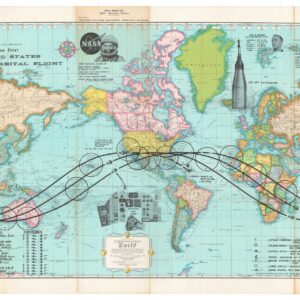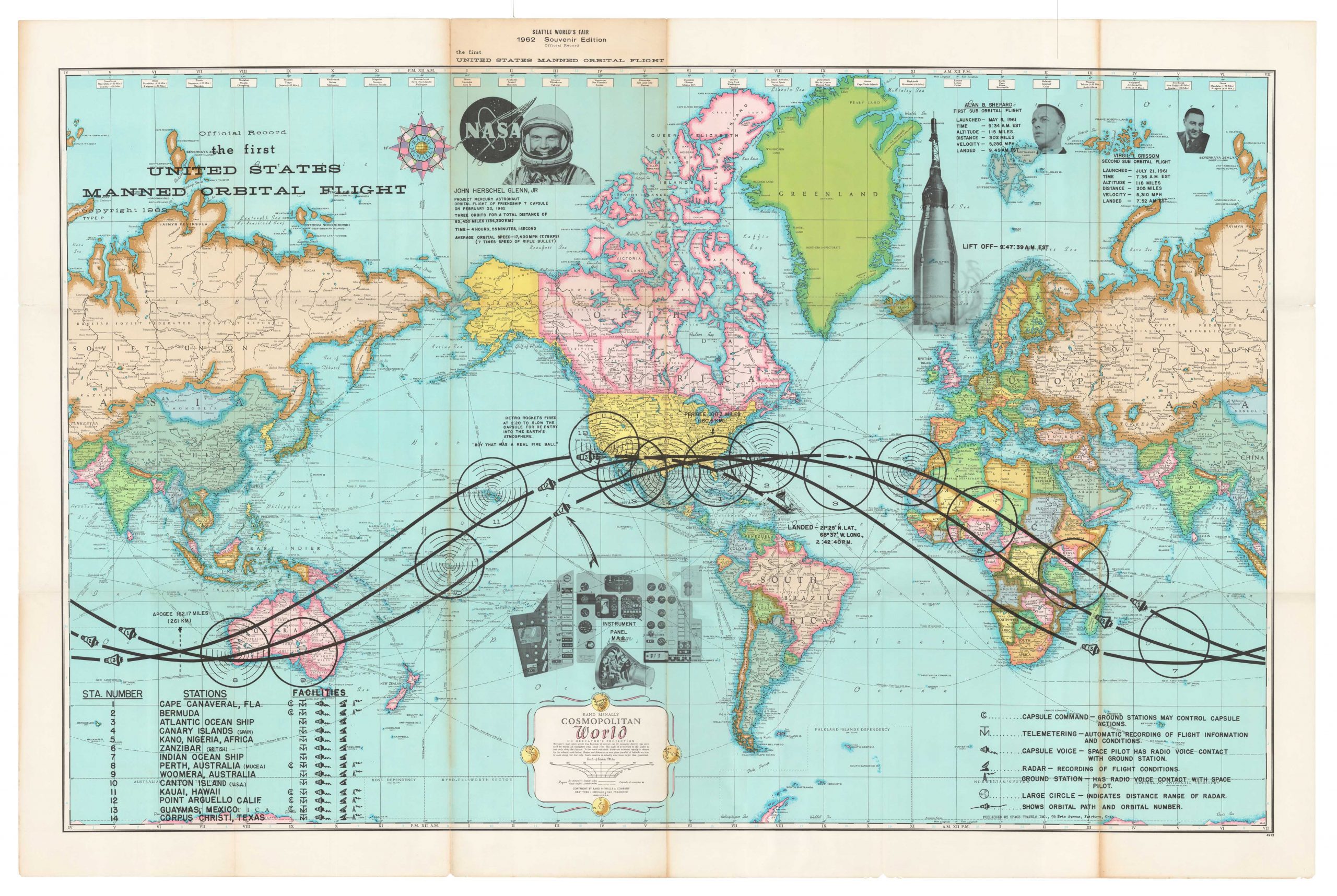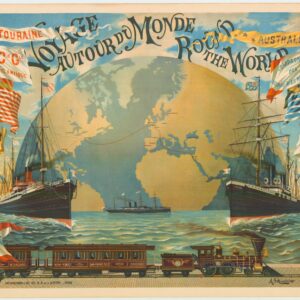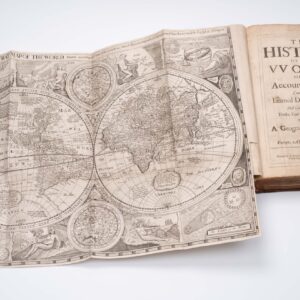A revolution in printed cartography, this is Gregor Reisch’s groundbreaking 1504 map of the world.
[Untitled Ptolemaic World Map]
Out of stock
Description
Produced around 1500 for the Margarita Philosophica (1503), a single-volume encyclopedia of higher knowledge, Gregor Reisch’s map set a new standard for mapmaking. The ideas embedded in Reisch’s chart were soon taken up by his student, Martin Waldseemüller, whose charts transformed how we see and map the world.
This map is the product of woodblock printing. It has an elongated and slightly upturned shape typical of Ptolemaic world maps of the late 15th and early 16th centuries. It is framed by a dark borderline and set in a diamond shape within that border. The Red Sea is rendered in original red wash color. Moreover, the fringes of the map are marked by a range of hand-written connotations in Latin, which appear to be roughly contemporary with the map itself. This assessment of age is based both on the Gothic writing style and the discoloration of the ink. The Gothic hand makes it hard to discern what precisely these annotations state, but as they are mostly single words or pairs, this suggests that they probably constitute revisions and additions of place names.
Surrounding the map are four wind-heads: one at the top, one at the bottom, and one on either side. While wind-heads themselves were not an unusual feature on maps from this era – essentially being one of the first indicators of nautical observations on European maps – in this particular case, they confirm that our map is the rare second state, first printed in 1504.
The map’s most famous feature is found in the physical attachment of Africa and Asia through a long southern land bridge. Even though depicting the Indian Ocean in this manner (i.e., as a closed maritime space) was not unusual in this era (an excellent example being Schedel’s 1493 map from the Nüremberg Chronicle), after Reisch published his seminal work, this trend abated rapidly. While this abatement is not directly attributed to Reisch, his map included one feature that made it stand out. Printed at the bottom of Reisch’s map is a comment that not only has baffled historians for ages but reflects the extent to which this was a landmark map. Written in large letters along the land bridge, Reisch added an observation in Latin that translates to: ‘Here is not land but sea, in which there are such islands not conceived by Ptolemy.’
These few words set Reisch’s map aside from its contemporaries and represent one of the most concrete indications found on any map of fundamental change in the way cartographers perceived the world. The statement hints that change, in large part, was driven by the voyages of exploration and trade undertaken in these years. Whether the annotation references Vasco da Gama’s discovery of an eastward route to India or if it refers to the discovery of the New World remains a mystery that even leading map scholars have had a hard time explaining (Shirley 1983: 21-22). Regardless, because the map was issued in perhaps the most widely distributed book of learning at the time, this revisionist notion spread like wildfire among the intelligentsia of the church.
Context is everything
Gregor Reisch was among the most renowned theological polymaths of the early 16th century. His most longstanding achievement is undoubtedly the Margarita Philosophica (Pearl of Wisdom), which included this map. The ‘Pearl’ was one of the first printed encyclopedias of knowledge. Twelve individual books espoused the principles of Latin grammar, dialectics, rhetoric, arithmetic, music, geometry, astronomy, physics, natural history, physiology, psychology, and ethics. For a man like Reisch, including a world map must have seemed natural. But being such an ardent and independent thinker – with an intellect to match his diversified interests – it was not sufficient for Reisch to follow standard procedure and simply copy an earlier chart. Instead, he inserted innovations and comments that took recent navigational accomplishments into account.
By overlaying the established Ptolemaic model with some of the insights gained from seafaring and exploration, Reisch helped set in motion the most significant paradigm shift in the history of cartography: namely, the replacement of ancient geographic templates with observation-based mapping. This transition was a drawn-out and complicated process, and the tendency towards observation-based navigational charts started long before Reisch. However, Reisch’s achievement with this map was to elevate geographic observation to the tier of academic cartography.
Reisch’s magnum opus was a huge success and soon became the most widely read textbook at universities. As with many contemporary educational works, Reisch composed the narrative as a dialogue between master and student. This relationship also sets Reisch’s map apart from his contemporaries. Being one of Europe’s prominent theological thinkers, Reisch was well connected with early humanists like Erasmus of Rotterdam and Johann Geiler von Kaysersberg – two of the most celebrated thinkers and orators of their age. Reisch was highly respected, and many of his students achieved even greater fame than he did. Johan Eck, for example, was one of the fiercest opponents with which Martin Luther had to contend. Regarding this map, however, a more important student was Martin Waldseemüller, who, following his studies with Reisch, produced charts that changed the trajectory of scientific cartography.
Waldseemüller’s output was probably the most important cartographic work produced by a single man in the history of mapmaking. His most famous contribution was his great 12-sheet world map and pamphlet Cosmographiae Introductio, published in 1507. In addition to showing the world in a completely new manner, the map also includes both the American continents and the first labeling of America. He was, in other words, a man who changed the entire game of mapmaking by rewriting the rules. But if Waldseemüller is the father of modern cartography, then Gregor Reisch could be said to be its grandfather. To truly understand why, let us take a closer look at this map.
Description and state
This map is an example of the rare second state of Reisch’s map. The first state was found in the original edition of the Margarita Philosophica, which was published in Freiburg by Johann Schott in 1503. The following year, Johann Grünninger, a publisher based in Strassburg, issued his own edition of the work, in which a new version of the map appeared. This version was reduced slightly in size and included only four wind-heads, the significance of which is discussed below. Furthermore, a dark line framed it, and the seascape was striated. The third official edition, published in Basel in 1508, returned to the original version of the map, without the frame, containing twelve wind-heads and a blank seascape. This sequence allows us to confirm the state of our particular map.
The map itself outlines perceived landmasses stretching from Europe’s west coast to the Far East. In addition to Europe and Asia in their entirety, the map also depicts the northern two-thirds of Africa. The map is full of the fascinating tropes that we know well from Ptolemaic geographies. In Europe, we find all the major countries represented, and mountain chains are generously drawn into this continent’s limited space. The easily recognizable labels are known regional identities such as Hispania, Anglia, Gallia, Germania, and Italia. Also labeled are some of Europe’s great rivers, including the Danube and Rhine. As soon as we move out of Europe, however, both place names and physiographic representations become sketchier and more consistent with European imaginings than actual reality.
Africa, for example, is almost void of any labeling, except for its Mediterranean coastline. The labels are primarily inland projections of more established toponyms (e.g., Libya Interior or Ethiopia Interior). A mountain range runs parallel to the Mediterranean, separating North Africa from its Sub-Saharan counterpart. While the mapmaker includes the Christian kingdoms of Ethiopia – a thoroughly medieval period concept – most of Africa’s geography follows the antiquated and deeply mythologized Ptolemaic model. The best examples of this trend are evident in the depiction of the Nile as flowing from an imagined South African range termed Mons Lunae, or the Mountains of the Moon. These mountains were a well-established concept in Ptolemaic-style maps of Africa and were the accepted model for explaining the origins of the continent’s greatest river. Tributaries originating at the Mons Lunae feed into two or three large interior lakes, which provide the Nile with its life-giving waters.
Many vestiges of a Ptolemaic worldview still saturate Reisch’s map. We have mentioned the depiction of Africa and its oddities; one can find similar tropes when examining his presentation of Asia. Among the more established visual ideas was, for example, the rendering of the Persian Gulf as an almost quadratic and closed sea. In this case, Reisch also shows off his historical knowledge by subdividing Persia into roughly identical units – almost like a grid system – to which he applies Hellenized place names. Many of these names refer to ancient peoples and kingdoms (e.g., Media, Parthia, Susiana, Gedrosia, or Drangiana) and would have come more or less directly from Ptolemy’s Geographia. Strewn across the Asian continent are also several labeled mountain ranges, and in the Far East, we even find a long jagged line representing the Great Wall of China (reported by Marco Polo).
While geographies executed in ecclesiastical circles remained relatively detached from the more functionalist tradition of portolan charts, the marriage between commerce and cartography could not be escaped. Reisch’s map shows an unmistakable focus on the Indian Ocean as the most crucial maritime space. Europe was obsessed with finding a direct route to Asia, and kings and lords funded numerous expeditions to achieve this goal in the years preceding our map’s publication. India and Southeast Asia (especially the Spice Islands) were the most popular trading destinations. The age-old mercantile interests in this region are at the root of resilient cartographic myths and errors, exemplified here by the depiction of Sri Lanka as an enormous island practically unrelated to the Indian Subcontinent. The critical factor to note here is not the error in size or placement but how European interests allowed the things deemed more important to dominate the visual field.
Other than the Indian Ocean, Reisch has largely omitted oceanic spaces from this map. There is, of course, no evidence of the Pacific (not understood by European cartographers at this time), and he depicts only a slither of the Atlantic. There is an enlarged Malay Peninsula in the east, beyond which Asia connects to Africa by a mythological Antarctic land bridge. This configuration suggests that Reisch was fully aware of Martellus’ famous map, printed in 1490, the first map that severed the land link between Africa and Asia. Instead, the Malay Peninsula was dramatically enlarged and turned westwards, creating what scholars and map collectors refer to as the “Dragon’s Tail.” The shape of Reisch’s Malay Peninsula clearly shows that he was aware of the Martellus map. But remembering his role as an educator, Reisch chose a different path, one in which he emulated Martellus’ peninsular model yet maintained the odd landbridge between Asia and Africa. Within this context, Reisch’s famous comment on Ptolemy is best understood. Unlike Martellus and later Waldseemüller, Reisch did not seek to revolutionize cartography. Instead, Reisch’s map was an attempt to narrate or explain some of the paradigm shifts that the field of geography was undergoing.
Conclusion
This map is extraordinary because it represents the underlying intellectual revolution that was intrinsically connected to the revisionism of the field cartography, which in turn drove the great voyages of exploration. On the one hand, it is a map that situates the viewer historically by anchoring us within an established and standard framework (i.e., the Ptolemaic world view), but on the other, it encourages us to look beyond the familiar by explicitly declaring at least parts of it as untruthful. Thus, while there are earlier maps that – especially in retrospect – reveal how our understanding of the world was changing at this point, what Reisch achieves is to make the discrepancy explicit. He uses the juxtaposition of graphic rendition against written statements to draw the inevitable conclusion that almost everything in the world can and should be questioned.
Cartographer(s):
Gregor Reisch (c.1467–1525) was a Carthusian scholar-monk from Germany who, during his lifetime, gained great renown as a polymath, educator, and counter-reformist theologian. His most significant achievement from a historical perspective was undoubtedly the publication of the Margarita Philosophica (The Pearl of Philosophy), the first encyclopedic work of knowledge ever produced. This work included individual volumes on grammar, philosophy, natural science, and ethics. It was used for general education at universities throughout Europe for almost two centuries, making it one of the single most influential books ever written.
Reisch spent most of his career in Freiburg, studying and teaching at the university there for many years and returning there as the prior of Freiburg Charterhouse towards the end of his life. From 1510, Reisch served as confessor to Holy Roman Emperor Maximilian I, and he was generally a fervent counter reformer and anti-Lutheran. This fervor was passed on to one of his most notable students, Johann Eck, who became an even more famous opponent to Luther’s teachings. Yet Reisch was also an early humanist, debating ethics and philosophy with the likes of Erasmus of Rotterdam, Jakob Wimpfeling, and Beatus Rhenanus.
Condition Description
Contemporary ink annotations. Minor repairs along the edges, top and bottom right corners leaf cast with neatline added in manuscript. Reinforcements to folds on verso. Overall a very nice example.
References





